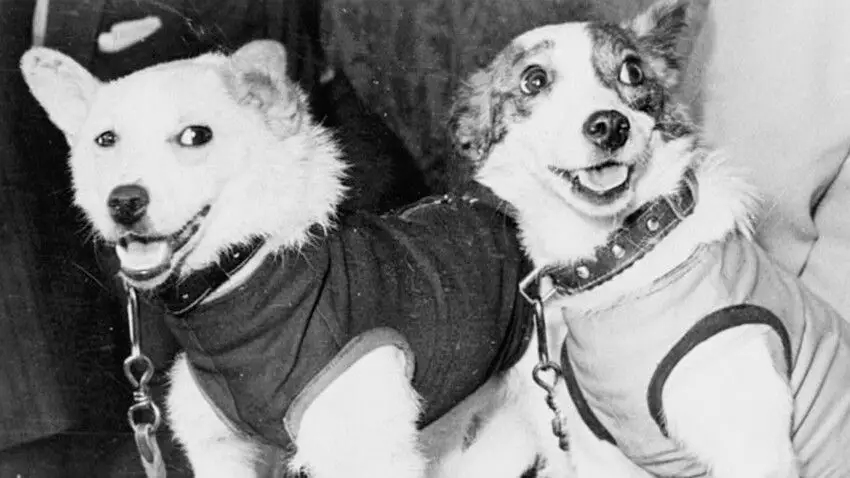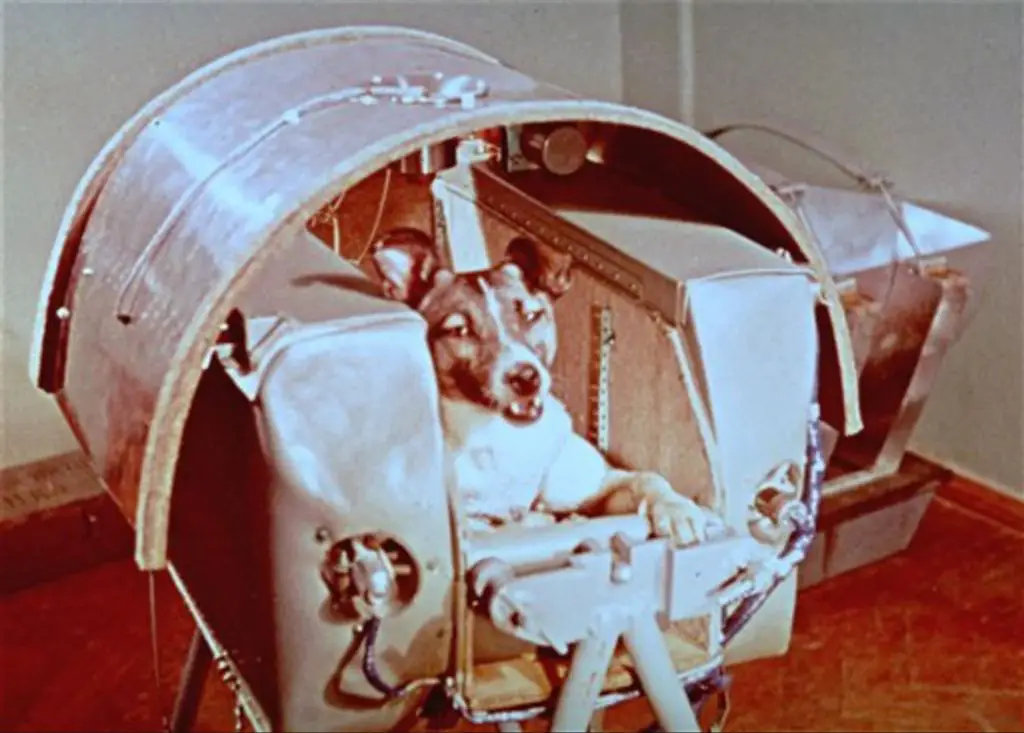Introduction
In the 1950s, the space race between the United States and Soviet Union was heating up. Both nations were vying to be the first to achieve key milestones like launching artificial satellites and sending humans into space. Given the many unknowns and risks of spaceflight at the time, animals were used for initial tests before risking human lives.
The Soviet Union had a particularly ambitious space dog program that sought to determine if living organisms could survive the launch and conditions of orbital spaceflight. After launching several dogs on suborbital flights, the Soviets set their sights on launching the first dog into Earth’s orbit in 1957.
This sets the context of the early space race and use of dogs to test spaceflight viability before humans. The article will tell the story of the first dog in space, providing details on the mission and legacy.
Early Spaceflight Tests
In the early days of the space race, scientists used animals to test the safety and feasibility of manned spaceflight. Mice, monkeys, dogs, and even fruit flies were launched into space before any human. These early tests helped space programs understand the effects of radiation and microgravity on biological organisms before risking human lives.
The Soviet space program launched the first animals into space in 1951 using R-1 rockets, including two dogs named Tsygan and Dezik. The United States sent some fruit flies aboard a V2 rocket to test radiation later that year. Over the next decade, both nations continued launching animals to orbit and returning them safely, gathering valuable data for future human spaceflight.
Dogs were viewed as ideal test subjects due to their intelligence, trainability, and anatomy similar to humans. By training them to wear space suits and endure the rigors of spaceflight, scientists could better understand the challenges faced by humans. As rocket and life support technology improved, dogs survived for longer durations and paved the way for manned orbital missions.

Selecting the First Dogs
Before Laika was launched into space on Sputnik 2 in November 1957, an intense process was undertaken by Soviet scientists to select and train suitable canine candidates for spaceflight. Stray dogs were gathered from the streets of Moscow and carefully screened based on their size, temperament, and physical condition. The ideal space dogs needed to be small enough to fit into the cramped capsules, even-tempered enough to endure the stressful launch and conditions of space, and sturdy enough to withstand the physiological challenges.
Laika, a small, part-husky mongrel found as a stray on the streets of Moscow, was one of several dogs enlisted into the Soviet space program in the early 1950s. She excelled in the intensive fitness and obedience regimes devised by scientists to test the dogs’ ability to adapt to the confinement of the spacecraft. Though lonely and nervous at first, Laika adjusted to the close quarters and long periods of inactivity during training. Her calm demeanor under pressure and good health made her the top choice for the Sputnik 2 mission.
While Laika’s biography from her life before becoming a space dog is unknown, her unique role in spaceflight history began with her selection by the Soviet space program. Along with other stray dogs recruited as astronauts, she pioneered the path for human space travel through her resilience during the challenging training and her ultimate sacrifice on Sputnik 2.
Sputnik 2 Mission
On November 3, 1957, Laika made history as the first living creature to orbit the Earth when she was launched on board the Soviet spacecraft Sputnik 2. Sputnik 2 was the second spacecraft launched as part of the Soviet space program’s Sputnik program, coming just a month after Sputnik 1’s successful launch.
The Sputnik 2 spacecraft weighed 508.3 kg (1,120 lb) and the payload totaled 113 kg (249 lb). Laika was placed in an isolated compartment within the spacecraft along with provisions for 7 days of oxygen, food and water. Sensors were placed on her body to record vital signs and other data throughout the mission.
Sputnik 2 was launched into orbit from the Baikonur Cosmodrome aboard the Vostok-K 8K72K rocket. It achieved orbit successfully and Laika became the first living being to orbit the Earth. While in space, sensors relayed data indicating Laika was agitated but eating her food. After a few hours, her heartbeat and respiration increased and they remained elevated for the remainder of the flight, likely indicating high stress levels.
Sputnik 2 spent 162 days in orbit with Laika on board before the batteries failed and it reentered Earth’s atmosphere on April 14, 1958. No provisions had been made for Laika to exit the spacecraft during or after the mission, so she died within hours from overheating and lack of oxygen as the spacecraft disintegrated on reentry. Though Laika did not survive, the Sputnik 2 mission provided scientists with valuable data on the effect of launch and weightlessness on a living passenger that helped pave the way for human spaceflight.

Laika’s Legacy
Laika’s journey into space sparked much controversy and debate over the ethics of sending a dog into space, knowing she would not survive the trip. At the time, the technology did not exist to safely return Laika back to Earth. While some saw Laika as a hero who paved the way for human spaceflight, others decried sending her to certain death as cruel exploitation. Animal rights groups condemned the decision to send a dog into space, seeing it as an inhumane use of animals for experimentation.
However, in the context of the intense space race between the Soviet Union and the United States, Laika’s mission provided key insights into how living organisms could survive in space. At the time, the effects of spaceflight on living beings were largely unknown. Laika’s journey advanced scientific knowledge and demonstrated that animals could tolerate microgravity, cosmic radiation, and the stresses of launch and orbit. While tragic, her sacrifice helped make manned space missions possible in the future.
Today, Laika is remembered as a space pioneer who gave her life for the advancement of science and space exploration. She demonstrated that animals could survive in space, paving the way for humans. Her mission captivated the world and she continues to be honored with statues, stamps, and other tributes celebrating her as a symbol of animal sacrifice for the greater good. Though controversial, her legacy sparked advances in rocketry and space medicine that ultimately helped humans achieve the dream of spaceflight.
Other Notable Space Dogs
While Laika was the first dog in space, she was not the only early space dog. The Soviet Union launched several other dog missions in the late 1950s and early 1960s to continue studying the feasibility of manned spaceflight. Some of the most notable include:
– Belka and Strelka – In 1960, these two dogs were launched into space on Sputnik 5, along with mice, rats and flies. Belka and Strelka were the first animals to actually return alive after orbiting the Earth.

– Chernushka – Launched on Sputnik 9 in 1961, Chernushka was a female dog that made one orbit of the Earth before returning alive.
– Pchyolka and Mushka – These two dogs were launched together on Sputnik 10 later in 1961 in the lead up to sending the first human into space. Both dogs were successfully recovered.
– Damka and Krasavka – In 1962, these street dogs became the last canine cosmonauts before manned orbital spaceflight became routine. They spent 22 days in space and survived.
These early space dog missions provided important physiological data on how organisms and life functions adapt to microgravity, cosmic radiation, and other spaceflight conditions prior to human space missions.
Impact on Manned Spaceflight
While tragic, Laika’s mission provided critical data on the viability of living organisms surviving launch and experiencing prolonged weightlessness and cosmic radiation exposure. This paved the way for human spaceflight milestones.
The insights from Laika’s flight were essential for Yuri Gagarin’s successful orbital flight as the first human in space in 1961. The lessons continued as space programs advanced, with Laika’s mission helping NASA determine how to keep astronauts safe during the Mercury, Gemini, and Apollo programs.
Laika’s contributions built confidence that humans could endure space travel, leading to Neil Armstrong’s historic first steps on the Moon in 1969. Data from Sputnik 2 also informed designs for life support systems and nutrition needs for long duration missions. In many ways, Laika’s sacrifice was instrumental to achieving manned orbital flights, Moon landings, and today’s continued human presence aboard the International Space Station.
Laika in Popular Culture
Laika’s flight in Sputnik 2 captured the imagination of people around the world and made her a cultural icon. She inspired books, films, artwork and even songs. Some examples include:
- Laika, a graphic novel by Nick Abadzis that tells Laika’s story from her perspective and won the 2008 Eisner Award.
- Dr. Pepper’s “Laika Boss” ad campaign in 2008 that featured Laika as an animated Soviet space commander.
- An Arcade Fire song called “Laika” on their album The Suburbs that mourns Laika’s death.
- A statue of Laika erected in 2008 near military research facility in Moscow where she was launched.
- Various breeds of dog named Laika in her honor, including a Finnish Spitz/Chow Chow mix.
Laika continues to be an iconic symbol of animal rights and the exploration of space. Her sacrifice paved the way for human spaceflight while also raising ethical questions about using animals for dangerous experiments.

Space Dog Breeding Program
After the launch of Sputnik 2 and Laika’s sacrifice, the Soviet space program continued experimenting with dogs in space for many more years. They established a rigorous breeding and training protocol to supply dogs for their spaceflights.
The ideal space dog was a stray mongrel female under 6 kg in weight. Mongrels were believed to possess better constitutions than purebred dogs. Strays were used because they were accustomed to harsh conditions and hunger. Females were preferred due to their lower waste requirements during long flights.
Dogs would go through months of intensive training to acclimate them to the confines of spaceflight. They were kept in small cages and learned to eat nutritious gelatinous food. Scientists observed the effects of vibration, noise, and G-forces on the dogs. Only those dogs that passed all tests were selected for missions.
Over the course of the Soviet space program, dozens more dogs were launched into space. Notable dogs included Belka and Strelka who became the first living creatures to orbit the Earth and return alive. Pictures of Strelka with her puppies helped convince the American public that spaceflight could be safe for humans.
The exploits of the Soviet space dogs demonstrated that living organisms could survive the rigors of launch and microgravity. This paved the way for human spaceflight missions like Yuri Gagarin’s historic orbital flight.
Conclusion
Laika’s flight on Sputnik 2 marked her as not only the first dog in space, but as an important pioneer in manned spaceflight. Even though she did not make it back safely to Earth, her sacrifice was necessary to prove that living organisms could survive launch and time in orbit. As tragic as her story was, given that her death was expected and planned for from the beginning, Laika’s part in space history cannot be overlooked. Without her fatal mission demonstrating key proof of concept, Yuri Gagarin and other humans may not have made it to space. Through commemorations of Laika around the world, she lives on as a symbol of animal rights and the ultimate sacrifice to push forward humanity’s knowledge. Future generations will know Laika’s name and remember her legacy.